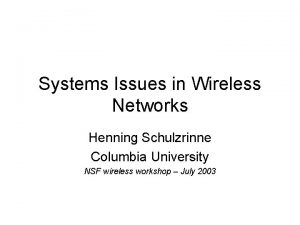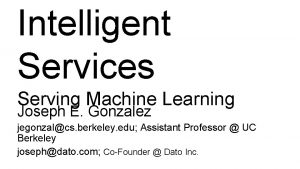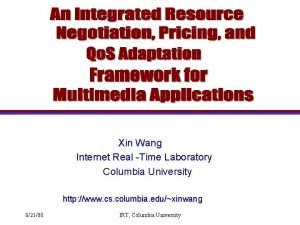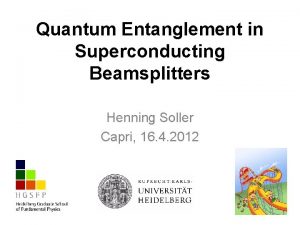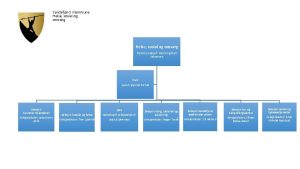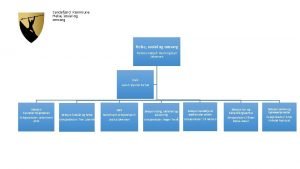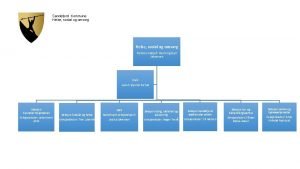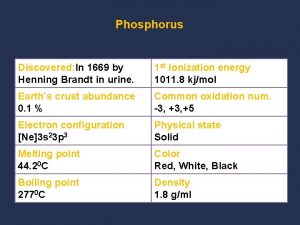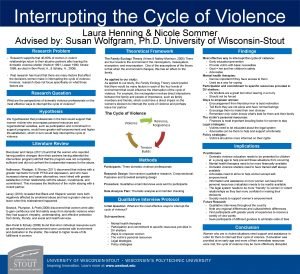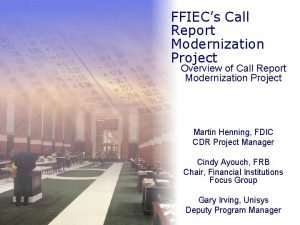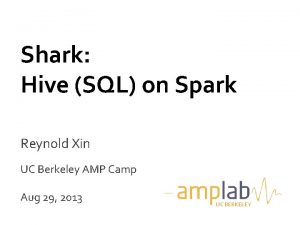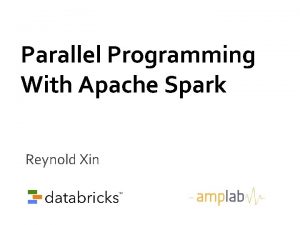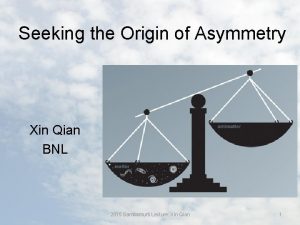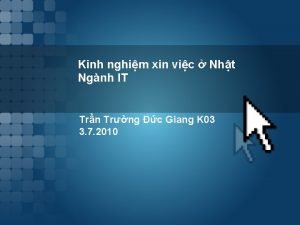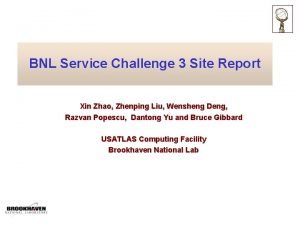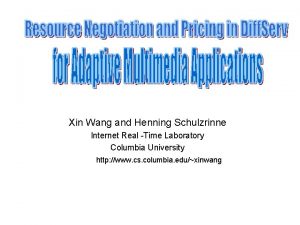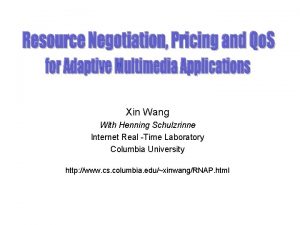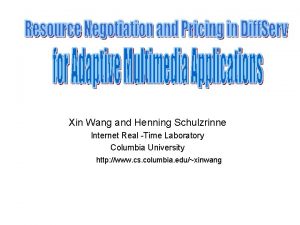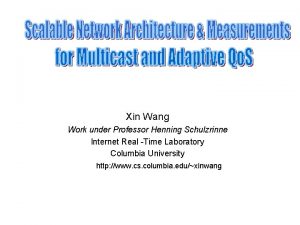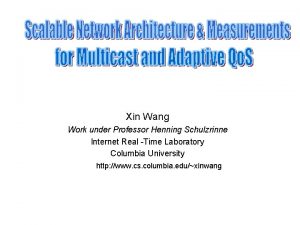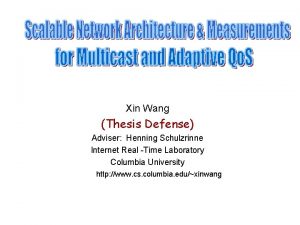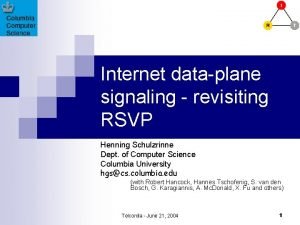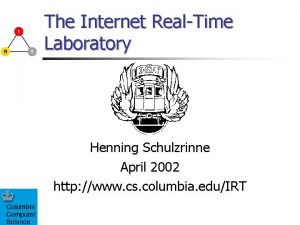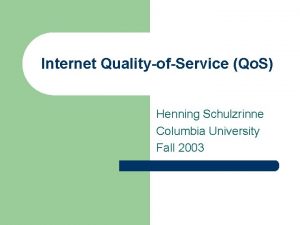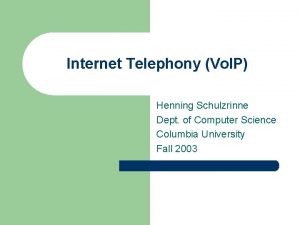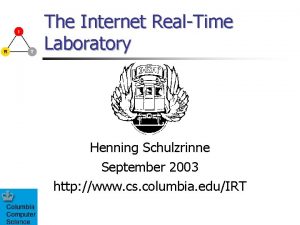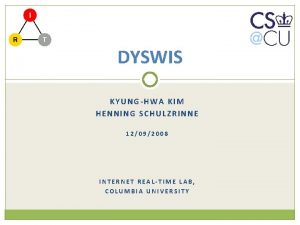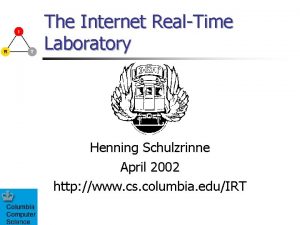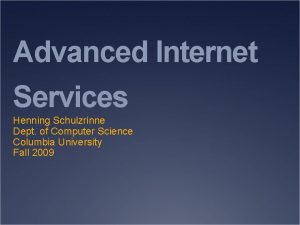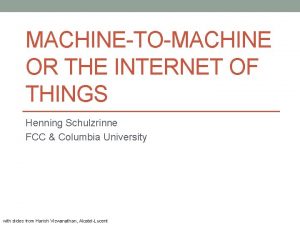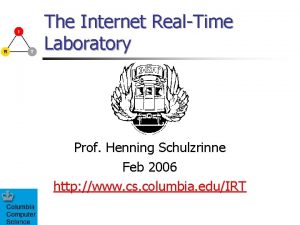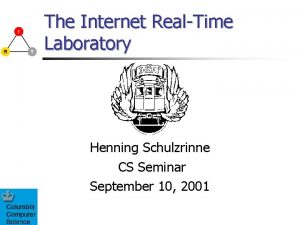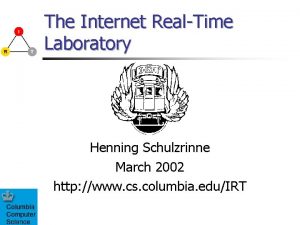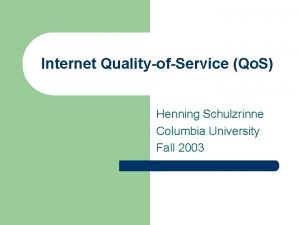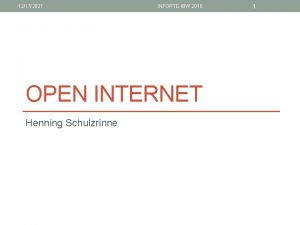Xin Wang Work with Henning Schulzrinne Internet Real
















































- Slides: 48

Xin Wang Work with Henning Schulzrinne Internet Real -Time Laboratory Columbia University http: //www. cs. columbia. edu/~xinwang/RNAP. html

Scope of Metropolitan IP Network Service Level Agreements (SLA) are negotiated based on Application Specific Needs bandwidth, loss, delay, jitter, availability, price A pp lic at io n SL A Application SLA Proliferation of new IP services and applications with different bandwidth and quality of service requirements presents significant opportunities and challenges for service providers for IP networks provisioning. 10/27/2021 2

The needs from Next Generation Service Providers n Increase revenue by offering innovative IP services: u u Delivering high-margin, differentiated services Vo. IP, VPN, Applications Hosting etc n Gain competitive advantage by deploying new services more quickly, placing a premium on time to market and time to scale n Reduce cost and operation complexity u u Evolve from static network management to dynamic service provisioning Reduce costs by automating network and service management It is critical for ISPs to offer premium IP services cost effectively to offset the declining revenue from the traditional connectivity services (raw bandwidth). 10/27/2021 3

Internet Structure End User Regional Provider NAP LAN POP Regional Provider Backbone Provider Private Peering Backbone Provider 10/27/2021 Private Peering Private Network 4

NORDUnet Traffic Analysis 10/27/2021 5

NORDUnet Traffic Analysis n Results: u All access links (interconnect ISP’s or connect private networks to ISP’s), including trans-Atlantic links, can get congested. u Average utilization is low: 20 -30% u Peak utilization can be high: up to 100 è Congestion Ratio (peak/average): as high as 5. u Peak duration can be very long: è Chicago NAP congested once in 8/00, lasted 7 hours. è Tele. Globe links congested every workday in 8/00 and 9/00 n Reasons: Frequent re-configuration and upgrading; Load balancing to protect own users. 10/27/2021 6

Solutions ? n Simply over-provisioning? u u Adding enough bandwidth for all applications Will over-provisioning be sufficient to avoid congestion? è How much bandwidth is enough to meet diverse user requirements? è No intrinsic upper limit on bandwidth use u n Quality of Service (Qo. S)? u u n How much it costs to add capacity? Conditioning the network to provide some predictability to an application How efficient a Qo. S mechanism manages the bandwidth? How much complexity? How much a user needs to pay for Qo. S? Application adaptation? u u Adapting the source rate based on network conditions to avoid congestion Why would an application adapt? To leave room for others? 10/27/2021 7

Bandwidth Pricing n Reality: leased bandwidth price has not been dropping consistently and dramatically. n Facts: u 300 mile T 1 price (rent): è 1987: $10, 000/month è 1992: $4, 000/month è 1998: $6, 000/month (thanks to high Internet demand) u 100 -mile cabling cost in 1998: $65, 000 Purchase a higher-speed connection if the option to manage the existing bandwidth to support the applications is available? What company can disregard high recurring monthly costs? 10/27/2021 8

Bandwidth Pricing (cont. ) n n Links connecting ISP’s are very expensive Facts: u International Frame Relay with 256 -kbps: thousands dollars a month. u Transit DS-3 link: $50, 000/month between carriers. u Transit OC-3 link: $150, 000/month between carriers. u Chicago NAP: è$3, 900/month/DS-3, è$4, 700/month/OC-3. Bandwidth may be cheap, but not free. We need a service model and pricing mechanism that would allocate bandwidth more efficiently. 10/27/2021 9

Solutions ? n Simply over-provisioning? u u Adding enough bandwidth for all applications Will over-provisioning be sufficient to avoid congestion? è How much bandwidth is enough to meet diverse user requirements? è No intrinsic upper limit on bandwidth use u n Quality of Service (Qo. S)? u u n How much it costs to add capacity? Conditioning the network to provide some predictability to an application How efficient a Qo. S mechanism manages the bandwidth? How much complexity it will add? How much a user needs to pay for Qo. S? Application adaptation? u u Adapting the source rate based on network conditions to avoid congestion Why would an application adapt? To leave room for others? 10/27/2021 10

What we add to these solutions? n Developed a service negotiation framework u n Proposed a Resource Negotiation And Pricing protocol RNAP: u u n Qo. S support + user adaptation, allows resource commitment for short intervals. Enables user and network (or two network domains) to dynamically negotiate services Can be embedded in other protocols, e. g. , RSVP, or implemented independently Proposed a pricing model u u u Enable differentiated charging to suppor multiple levels of services Considers long-term user demand Allows for congestion pricing to motivate user adaptation 10/27/2021 11

Goals n Achieve Network Efficiency u Maintain a target level of service while minimizing the resources needed to provide this service u Improves network availability and Qo. S for the users u Allow a service class to meet its performance assurances under large or bursty offered loads, without high network management overhead, or over-provision cost n Achieve Economic Efficiency u Price services levels to reflect the Qo. S cost u Under resource contention, allocate resources to the users that value them most u Maximize the user benefit, maximize network revenue 10/27/2021 12

Protocol Architectures: Centralized Host Resource Negotiator NRN HRN RNAP Messages NRN Network Resource Negotiator NRN HRN Access Domain - A Edge Router Internal Router Access Domain - B Transit Domain Intra-domain messages RNAP-C 10/27/2021 13

Protocol Architectures: Distributed RNAP Messages HRN LRN LRN Access Domain - A LRN LRN HRN LRN Edge Router Internal Router LRN Access Domain - B Transit Domain RNAP-D 10/27/2021 14

RNAP Messages Query: Inquires about available services, prices Periodic re-negotiation Query Quotation: Specifies service availability, accumulates service statistics, prices Commit Reserve: Requests/Updates service(s), resources Reserve Quotation Reserve price or denies it. Commit Close Release 10/27/2021 Commit: Admits the service request at a specific Close: Tears down negotiation session Release: Releases the resources 15

Message Aggregation (RNAP-D) Turn off router alert Turn on router alert Sink-tree-based aggregation 10/27/2021 16

Message Aggregation (RNAP-C) NRN 10/27/2021 Sink-tree-based aggregation 17

RNAP Message Aggregation Summary n n Aggregation when senders share the same destination network Messages merged by source or intermediate domains n Messages de-aggregated at destination border routers (RNAPD), or NRNs (RNAP-C) n Original messages sent directly to destination/source domains without interception by intermediate RNAP agents; aggregate message reserves and collects price at intermediate nodes/domains n Overhead Reduction u Processing 10/27/2021 overhead, storage of states 18

Block Negotiation Aggregated resources are added/removed in large blocks to minimize negotiation overhead and reduce network dynamics Bandwidth n time 10/27/2021 19

Pricing in Current Internet n Access-rate-dependent flat charge (AC) u u u n Usage-based charge u u n Simple, predictable Difficult to compromise between access speed and cost No incentive for users to limit usage congestion Volume-dependent charge (V) Time-base charge (T) è work better for uniform per-time unit resource demands, e. g. , phone Access charge + Usage-based charge u u Per-hour charge after certain period of use, or per-unit charge after some amount of traffic transmitted. Flat charge for basic service, usage charge for extra bandwidth or premium services 10/27/2021 20

Two Volume-based Pricing Strategies n Fixed-Price (FP): fixed unit volume price u u u n FP-FL: per-byte charge are same for all services FP-PR: service class dependent FP-T: time-of-day dependent FP-PR-T: FP-PR + FP-T During congestion: higher blocking rate OR higher dropping rate and delay Congestion-Price-based Adaptation (CPA): FP + congestion-sensitive price component u u u CP-FL, CP-PR, CP-T, CP-PR-T Congestion price calculation: Tatonnement process or auction During congestion: users maintain service by paying more OR reduce sending rate OR lower service class 10/27/2021 21

n 10/27/2021 Monetary levels of interactions at tes Ra c Pla ity nn ing pa Ca short-term Fl n so u Re rce ser va tio Re atomic ng Pr esti ici on ng Ti m Pr e-of ici -d ng ay Co ed b Flo ack w Co Re ntr tra o nsm l iss ion n Fe ng cin Ro g uti n Sc g he du Er lin g ro r. H an dli Po li Important Time Scales Technical levels of interactions medium-term long-term time 22

Pricing Strategies n Holding price and charge: cost by depriving others’ opportunity to be admitted even if no data is sent u n Usage price and charge: optimize the provider’s profit u u n phj = j (pu j - pu j-1) , chij (n) = ph j r ij (n) j max [Σl x j (pu 1 , pu 2 , …, pu. J ) puj - f(C)], s. t. r (x (pu 2 , …, pu. J )) R cuij (n) = pu j v ij (n) Congestion price and charge: drive demand to supply u Tatonnement process (CPA-TAT): è pc j (n) = min [{pcj (n-1) + j (Dj, Sj) x (Dj-Sj)/Sj, 0 }+, pmaxj ] è ccij (n) u = pc j v ij (n) Second price auction(CPA-AUC): charge as the highest biding price of the requests being rejected. 10/27/2021 23

Usage Price for Differentiated Service n Usage price based on cost of class bandwidth: u n Parameters: u pbasic rate for fully used bandwidth j : expected load ratio of class j xij : effective bandwidth consumption of application i Aj : constant elasticity demand parameter Price for class j: puj = pbasic / j u Demand of class j: xj ( puj ) = Aj / puj u u n n n lower target load (higher Qo. S) -> higher per-unit bandwidth price Effective bandwidth consumption: xe j ( puj ) = Aj / ( puj j ) Network maximizes profit: u max [Σl (Aj / pu j ) pu j - f (C)], puj = pbasic / j , s. t. Σl Aj / ( pu j j ) C Hence: pbasic = Σl Aj / C , puj = Σl Aj /(C j) 10/27/2021 24

Rate Adaptation of Multimedia System n n Utility/cost/bud n Enable multimedia applications to gain optimal perceptual value based on the network conditions and user profile. A Host Resource Negotiator (HRN) negotiates services with network on behalf of a multimedia system. Utility function: users’ preference or willingness to pay U 1 U 3 get 10/27/2021 U 2 Cost Budget Bandwidth 25

Utility n User adaptation under CPA-TAT u u n Optimally distributes network-allocated among applications in a multimedia system, optimize the system performance U = Σi Ui (xi (Tspec, Rspec)] max [Σl Ui (xi ) - Ci (xi) ], s. t. Σl Ci (xi) b , xmini xmaxi Determine optimal Tspec and Rspec User adaptation under CPA-AUC u u Literature model: not consider short-term resource reservation; not address user response to price change; assume unique service request; service uncertainty, signaling burst, setup delay M-bid auction model: express bid for a number of bandwidth; network select one that has the lowest bidding price 10/27/2021 26

Example Utility Function n n User defines utility at discrete bandwidth, Qo. S levels Utility is a function of bandwidth at fixed Qo. S u u u n Function of both bandwidth and Qo. S u u u n An example utility function: U (x) = U 0 + log (x / xm) U 0 : perceived (opportunity) value at minimum bandwidth : sensitivity of the utility to bandwidth U (x) = U 0 + log (x / xm) - kd d - kl l , for x xm kd : sensitivity to delay kl : sensitivity to loss Optimization: u u u max [Σl U 0 i + i log (xi / xmi ) - kdi d - kl i l - pi xi ], Σl pi xi b , x xm , d D, l L s. t. Without budget constraint: x i = i / pi With budget constraint: b i = b ( i / Σl k ) 10/27/2021 27

Stability and Oscillation Reduction n n Congestion-sensitive pricing (tatonnement process) has been shown to be stable (see web page for proof) Oscillation reduction u Users: re-negotiate only if price change exceeds a given threshold u Network: update price only when traffic change exceeds a threshold; negotiate resources in larger blocks between domains 10/27/2021 28

Test-bed Architecture RAT VIC n Demonstrate functionality and performance improvement: u Mbus n Host u u HRN RN AP n u n 10/27/2021 HRN negotiates resources for a system Host processes (HRN, VIC, RAT) communicate through Mbus Network u NRN blocking rate, average loss and delay, price stability, perceived media quality Free. BSD 3. 4 + ALTQ 2. 2, CBQ extended for Diff. Serv NRNs: è Process RNAP messages è Admission control, monitor service statistics, compute price è At edge, dynamically configure the conditioners and form charge Inter-entity signaling: RNAP 29

Functions of Routers n Interior routers: per-class policing, e. g, TBMETER (in/out) for a class n Edge routers: flow conditioning/policing based on SLA 10/27/2021 30

Network Resource Negotiator (NRN) n Provide price for each service class n Measurement-based admission control u predict future demand, update congestion price based on predictions 10/27/2021 31

Network States n n Per-class bandwidth and price variations blocking reduction due to adaptation 10/27/2021 32

Adaptive Wireless Terminal n n WAP development over Nokia Toolkit 2. 0 Currently cell phone services: u Flat pricing and best effort: all users get worse quality (coarse voice, busy signal, cut off) when congestion occurs. n Using our solution: u Provide real-time pricing information, e. g. , every 10 minutes or every call u Customers choices: è è è pay a premium to have best quality pay less by tolerating worse quality back off to call another time. u Reduce 10/27/2021 the blocking rate of overall network 33

Simulation Design n Performance comparison: u u n Network with dynamic services and rate-adaptive users and network with no adaptive users Fixed price based policy (FP): usage price + holding price versus congestion price based adaptive service (CPA): usage price + holding price + congestion price Four groups of experiments: u u Effect of traffic burstiness Effect of traffic load Load balance between classes Effect of admission control 10/27/2021 34

Performance Measures n Engineering metrics u Bottleneck traffic arrival rate u Average packet loss and delay u User request blocking probability n Economic metrics u Average and total user benefit u End to end price, and its standard deviation u Network revenue 10/27/2021 35

Simulation Modeling n n n Network Simulator (NS-2) Weighted Round Robin (WRR) scheduler Three classes: EF, AF, BE u EF: tail dropping, limited to 50 packets; load threshold 40%, delay bound 2 ms, loss bound 10 -6 u AF: RED-with-In-Out (RIO), limited to 100 packets; load threshold 60%, delay bound 5 ms, loss bound 10 -4 u BE: Random Early Detection (RED), limited to 200 packets; load threshold 90%, delay bound 100 ms, loss bound 10 -2 Sources: on-off or Pareto on-off (shape parameter: 1. 5) Negotiation period: 30 s, session length 10 min 10/27/2021 36

Simulation Architecture Topology 1 (60 users) 10/27/2021 Topology 2 (360 users) 37

Load Balance between Classes Variation over time of the price of AF class 10/27/2021 Ratio of AF class traffic migrating through class re-selection 38

Effect of Traffic Burstiness Average packet delay 10/27/2021 Average packet loss 39

Effect of Traffic Burstiness (cont’d) Price average and standard deviation of AF class 10/27/2021 Average user benefit 40

Effect of Traffic Load (cont’d) Average packet delay 10/27/2021 Average packet loss 41

Effect of Traffic Load Price average and standard deviation of AF class 10/27/2021 Average user benefit 42

Load Balance between Classes (cont’d) Average packet delay 10/27/2021 Average packet loss 43

Effect of Admission Control Average packet delay 10/27/2021 Average packet loss 44

Effect of Admission Control (cont’d. ) Average and standard deviation of AF class price 10/27/2021 User request blocking rate 45

Conclusions n RNAP u u u n Pricing model u n Supports dynamic service negotiation, mechanisms for price and charge collation, auction bids and results distribution Allows for both centralized and distributed architectures Supports multi-party negotiation: senders, receivers, or both Can be stand-alone, or embedded inside other protocols Reliable and scalable Consider both long-term user demand short-term traffic fluctuation; use congestion-sensitive component to motivate user demand adaptation upon resource scarce Application adaptation u Maximize users’ perceptual value, tradeoffs between quality and payment 10/27/2021 46

Conclusions (cont’d) n Auction Model u n Serves more users than comparable schemes, and has less signaling overhead and greater certainty of service availability Simulation results u u Differentiated service requires different target loads in each class CPA policy coupled with user adaptation effectively limit congestion, provide lower blocking rate, higher user satisfaction and network revenue than with the FP policy Both auction and tatonnement process can be used to calculate the congestion price; auction scheme gains higher perceived user benefit and network utilization at cost of implementation complexity and setup delay Without admission control, service is assured by restricting the load to the targeted level; with admission control, performance bounds can be assured even with FP policy, but CPA reduces the request blocking rate greatly and helps to stabilize price 10/27/2021 47

Conclusions (cont’d) u u n Allowing service class migration further stabilizes price Users with different demand elasticity share bandwidth proportional to their willingness to pay Even a small proportion user adaptation results in a significant performance improvement for the entire user population Performance of CPA further improves as the network scales and more connections share the resources Future work u u Propose light-weight resource management protocol Resource management in wireless environment 10/27/2021 48
 Henning schulzrinne
Henning schulzrinne Xin wang uc berkeley
Xin wang uc berkeley Xin wang columbia law
Xin wang columbia law Entanglement
Entanglement Brad henning
Brad henning Henning fjell johansen
Henning fjell johansen Henning kurz
Henning kurz Erich fromm haben oder sein
Erich fromm haben oder sein Henning fjell johansen
Henning fjell johansen Banana sunrise chair
Banana sunrise chair Matthias henning
Matthias henning Henning fjell johansen
Henning fjell johansen Henning kurz
Henning kurz Wade henning
Wade henning Henning hermjakob
Henning hermjakob Chemical properties of phosphorus
Chemical properties of phosphorus Laura henning
Laura henning Henning jørgensen aau
Henning jørgensen aau Jan henning pedersen
Jan henning pedersen Martin henning fdic
Martin henning fdic What is internet
What is internet Reynold xin
Reynold xin Con xin dâng lên muôn lời suy tôn
Con xin dâng lên muôn lời suy tôn Xin dâng lời cảm tạ hồng ân thiên chúa bao la
Xin dâng lời cảm tạ hồng ân thiên chúa bao la Lạy cha xin tha cho họ
Lạy cha xin tha cho họ Một người ăn xin đã già
Một người ăn xin đã già Big data is like teenage
Big data is like teenage Funeral banner of lady dai
Funeral banner of lady dai Xin cho lòng chúng con luôn mở rộng
Xin cho lòng chúng con luôn mở rộng Lạy chúa chí ái tiếng con nài xin
Lạy chúa chí ái tiếng con nài xin Linh hồn tôi ơi hãy ngợi khen thiên chúa
Linh hồn tôi ơi hãy ngợi khen thiên chúa Reynold xin
Reynold xin Maranatha, lời nguyện thiết tha
Maranatha, lời nguyện thiết tha đông qua mau trúc xinh nghiêng nghiêng đợi chờ
đông qua mau trúc xinh nghiêng nghiêng đợi chờ Hãy chỗi dậy hỡi ai ngủ mê
Hãy chỗi dậy hỡi ai ngủ mê Xin giữ con để con phụng sự chúa
Xin giữ con để con phụng sự chúa Xin qian bnl
Xin qian bnl Xin than linh den
Xin than linh den Wirecell
Wirecell Comp9313
Comp9313 Slidetodoc.com
Slidetodoc.com đấng sống muôn đời
đấng sống muôn đời Khi chúa thương gọi tôi về
Khi chúa thương gọi tôi về Cho xin
Cho xin Ee tat xin
Ee tat xin Chúng con cầu xin nhờ đức kito con chúa
Chúng con cầu xin nhờ đức kito con chúa Xin vic
Xin vic Xin zhao challenge
Xin zhao challenge Hongyi xin
Hongyi xin
